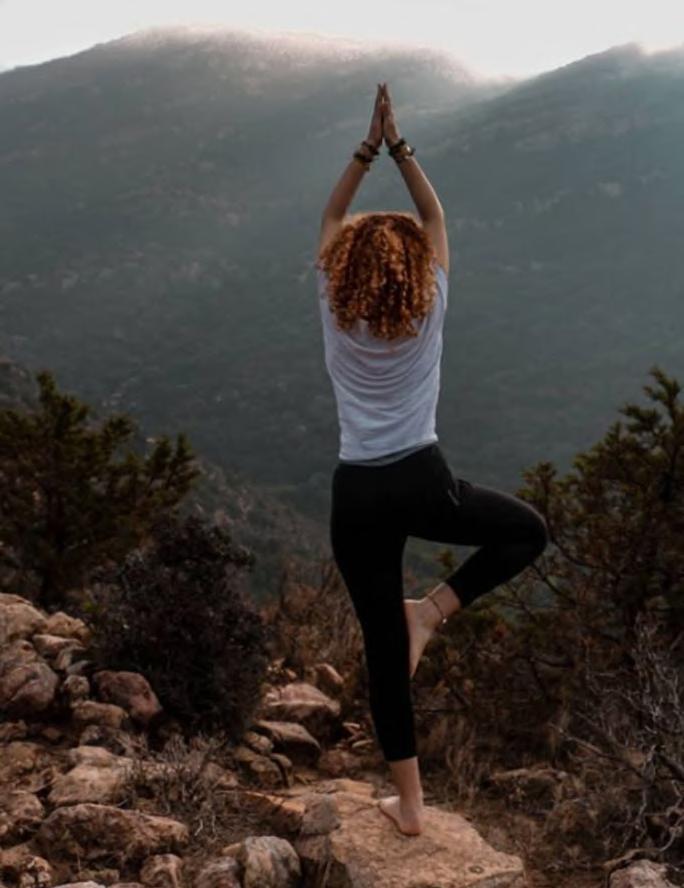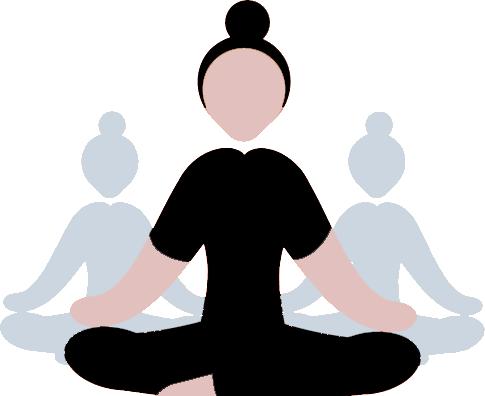
17 minute read
I.1.b. The Retreat Experience as a journey to Self-Discovery through Nature & Other
INTRODUCTION
Within you there is a stillness and “ sanctuary to which you can retreat at any time and be Yourself HERMANN HESSE*
Advertisement
Each one of us needs to have his own Inner Journey to his true Self, this adventure that remains unexploded, with no distractions far away from the daily routine and the usual place. So taking the time to pull back, and have a break from all the noise is essential to gain distance and perspective from the circumstances of our lives, to reflect and reconnect to oneself. Given what has been said, we will introduce the concept of the Retreat which will afford the opportunity to Self Discovery.
The Retreat gives also your body and mind the space they require to deal with ingrained trauma and assist you in discovering your true authentic self and desires.
A/ Definition of a Retreat :
Dictionary Retreat
Etymology
to move back and away from someone or something a private and safe place where you can be alone ( a refuge) to back up The word “retreat” comes from the Latin root “retreten” “trahere” = meaning to “draw back.”

It is breaking with our usual activities, reflexes and thoughts and establishing a new slower pace of life and allowing ourselves a break of a few days away from everything that makes our daily lives in a natural place to allow connection with nature and ourselves, learn how to integrate wellness into our lives and reflect.
Figure n°4: glimpse of our daily life (author source)




Retreating ... Healing ...
Figure n°5: Different activities during a Retreat (personal sketches)
*Hermann Hesse : a german-swiss poet, novelist and painter Page
I.1.b.
In general, the retreat is a pause that is held in serene locations with lush landscapes that allow you to reconnect with your true self and with nature and escape the hustle and bustle of daily life.
B/ Different Types of retreat :

a/ Among Sufis :
a.1/ Al Khalwah :
Khalwah, a crucial component of Islamic spirituality, in most Sufi traditions, means retreat or withdrawal from the world. Khalwa specifically refers to a period of time spent retreating from society in order to transform awareness and establish a more profound connection with the divine. Sufis who engage in khalwa isolate themselves for forty days with a spiritual guide while reciting the name of Allah nonstop.
Without engaging in khalwa, it may be difficult for the faithful to discover true knowledge, enlightenment, and proximity to the divine intent. Many Sufi religious leaders organize retreats where seekers can withdraw into isolation and introspection with the assistance of a skilled Sufi guide to facilitate khalwa practice.

Figure n°6: The exposition “WIRD” of the photographer Bruno Hadij (Source Author)

“The Khalwah takes place in closed and dark spaces except for an open hole that barely allows a thin beam of light to pass to create a balance between space and time. In the back of the room and in total silence, the Murafiq stands. Through this silence represented by the Khalwah, the image must unite with this darkness and be allied to it.7”
BRUNO HADIJ
a.2/ Al I’tikaf :
I’tikaf means ‘remaining’ somewhere. It is a three-day spiritual retreat to build one's self; it is the act of abandoning one's personal home to serve Allah while also recognizing one's self in the Masjid. It is a group spiritual retreat that helps people achieve mental serenity and sanctifies their inner selves. The spiritual retreat links hearts in such a way that there is no need to reach out to others.
Retreating ... Healing...
Page
b/ Among Budhists :
A retreat can be a period of seclusion or a time of community. Some retreats are held in silence, while others may have a lot of talk, depending on the host facility's and the participant's knowledge and accepted norms. Retreats are frequently held in rural, distant natural areas. Some experienced practitioners may choose to withdraw in complete darkness, which is a popular advanced technique.
Spiritual retreats provide time for introspection, Figure n°8: Sesshin retreat (Source thezengateway.com) prayer, and meditation. They are considered fundamental in Buddhism, having been a prevalent practice since the founder of Buddhism, Gautama Buddha, initiated the Vassa, or rainy season retreat. Sesshin is the essence of Zen practice and lasts three weeks. Each sesshin provides a one-of-a-kind chance free of distractions for us to focus our attention on the practice of meditation. Sesshin is a rewarding and hard component of most people’s practice. It is an opportunity to gather and concentrate one’s energy in order to clarify life. The Christian retreat is most simply characterized as a set period of time (from a few hours to a month) spent apart from one's everyday life for the purpose of reconnecting with God, usually through prayer. Although the practice of abandoning one's daily life to interact with God on a deeper level, whether in the desert) or in a monastery. Themes for spiritual retreats can promote Christian ideals, beliefs, and scriptural comprehension. They might be individual or group activities. Christian youth groups frequently have retreats.

c/ Among Christians :

C/ What are the Benefits of Attending a Wellness Retreat ?
Retreats are enriching getaways that offer a safe sanctuary for a deeper physical and emotional withdrawal from the stresses and strains of daily life. In fact, “there is some evidence to suggest that the benefits don’t end when the retreat does. A 2018 study by BMC Complementary Medicine found the positive impacts can last for up to five years after the retreat ends. It’s worth considering how a retreat can be integrated into your broader wellness goals and plans.” 8 And another post-retreat scans revealed decreases in dopamine transporter (5-8 percent) and serotonin transporter (6.5 percent) binding, which could make more of the neurotransmitters available to the brain.

Figure n°7: Toward Light (Source Author)
Retreating ... Healing...
Page
This is associated with positive emotions and spiritual feelings 9 So the individual will be able to adjust his perspective and become receptive to the potential of transformation and healing because of this separation from the norm. Wellness getaways have advantages for various aspects of your life, including emotional pain and blockages to aiding mental clarity .
TIME TO REFLECT, RENEW AND RESTORE
Jiddu Krishnamurti, a spiritual Indian leader and philosopher explains it clearly: “I think it is essential sometimes to go into retreat, to stop everything that you have been doing, to stop your beliefs and experiences completely and look at them anew, not keep on repeating like machines whether you believe or don’t believe. You would let fresh air into your minds.”
AWAY FROM YOUR HOME AND DAILY
Wellness retreats are typically held in tranquil settings near to nature, providing you with the ideal backdrop and space to unwind and forget about the stresses of daily life.
According to research, people who have stronger connections to nature tend to be happier overall and are more inclined to believe that their lives are valuable. Numerous pleasant emotions, including serenity, joy, creativity, and the ability to focus, can be produced by nature.
Making bad decisions is a result of multitasking and a dependence on digital stimulation. In the age of email, text messages, and social media, we frequently find ourselves juggling multiple tasks at once. According to neurologist Earl Miller, multitasking has been shown to boost the stress hormone’s production, which can overstimulate your brain and result in mental fog or jumbled thinking. The exact reverse is true of mindfulness and meditation; both practices involve giving your actions conscious attention in order to help you make wise choices. NATURE ALLOWS YOU TO UNWIND
UNPLUG FOR IMPROVED DECISION MAKING

SUMMARY / CONCLUSION
KHALWAH BUDHI RETREAT
closed + Dark + a thin beam of light Surrounded by Nature

+ All types of retreats are held in nature , quiet and faraway places where the self-quester* can find an adequate environment with no distractions to reconnect to his inner self. So,
Quitenes, distance and reconnection with nature are fundamental things during a retreat. + The Retreat oscillates between being alone with oneself (solitude) and being surrounded by other individuals (companionship) that share the same experience. Retreating ... Healing...

Page Page
D/ Why Reconnecting with Nature is important ?
“
Humans are a part of nature, not apart from nature. “ MARC BEKOFF *
Connecting with nature helps reconnecting with the inner self and with the world. It is a necessary component of who we are and shapes how we interact with one another and other living things. Our spiritual wellbeing depends on realizing that nature is not merely an aspect of our surroundings but also a component of who we are. Time spent in nature strengthens our bonds with one another and the wider world, according to a series of field experiments done by Kuo and Coley at the Human-Environment Research Lab.

Figure n°9: Walk as if you are kissing the earth with your feet (Source Author) This experience of connection may be explained by studies that used fMRI to measure brain activity. Participants’ empathy and love-related brain regions lit up when they saw scenes of nature, whereas their fear- and anxiety-related brain regions lit up when they watched scenes of cities. It seems that nature stirs up emotions that bind us to one another, our surroundings, and ourselves. This need and the human-dependency on nature is also explained through theories, here we present some.
a/ Ecopsychology :
Ecology Psychology

Eco = derives from the Greek oikos which means “home.” the Logos = study, order, meaning, speech of the Psyche = soul

Ecology is the study of the interactions between living things, such as humans, and their natural surroundings. It aims to comprehend the crucial interconnections that exist between living things such as plants, animals, and humans. The study of the mind and behavior is known as psychology. It includes biological variables, societal pressures, and environmental factors that influence how people think, act, and feel.
Ecopsychology
The psyche in relation to its earthly or natural home
Ecopsychology studies the relationship between human beings and the natural environment through both ecological and psychological principles. Ecopsychology seeks to develop and understand ways of expanding the emotional connection between individuals and the natural environment, thereby assisting individuals with :
developing sustainable lifestyles
Retreating ... Healing...
remedying the disconnect with nature
Page
I.1.b.
Ecopsychology believes that ecological and human psychological health are intertwined. According to this viewpoint, nature is both a part of and related to by humans. People have a profound sense of tranquility when they re-establish contact with nature. People begin to feel at home in both their physical bodies and the natural world as they begin to come to their senses. They start to experience a sense of inclusion in the world. Additionally, they have access to strong emotions and feelings. This results in profound healing. Robert Greenway, a writer for Abraham Maslow, was the first to conceptualize ecopsychology. With his mentors Michael Breen, he explored his theory that “the mind is nature, and nature is the mind.” He named his theory psychoecology and presented it in a graduate school essay at Brandeis University in 1963. Theodore Roszak, a well-known cultural historian, began writing about the subject in 1990. He rearranged the phrase ecopsychology from the portmanteau psychoecology in it. 1992 saw the release of his work in the book The Voice of the Earth. On the other hand, ecopsychologist and psychologist Jeffrey Rink asserts that people can awaken just by being exposed to nature, promoting profound healing and self-growth.

The physical separation from nature leads to a psychological dysfunction. And this disconnection, alienation or overall dysfunction may lead to

social and collective suffering such as racism, sexism, violence, and alienation from society Disconnecting with the inner self
individual human suffering such as anxiety, depression, and anger
Finally, by disconnecting ourselves from nature, we are endangering not only our well-being, but also we are disconnecting from ourselves and we became stranger to our own selves.
b/ Biophilia :
The instinctual human need to connect with nature and other living things is known as biophilia. The phrase literally translates to "love of life" because it comes from the Greek words for "life" and "love or compassion."
In order to retain a connection to nature inside the constructed environment, biophilic design makes use of natural materials, patterns, and phenomena. Biophilic design has been shown to support cognitive function, physical health, and psychological well-being, making it more than just a philosophy.

Retreating ... Healing...
Figure n°10: Into the Sea (Source Author)
Page
I.1.b.
The term "biophilia" was first used by psychologist Erich Fromm in 1964 to refer to "the passionate love of life and all that is living." Following the publication of Edward O. Wilson's book Biophilia in 1984, the term "biophilia" as a concept gained increased recognition. Wilson, an American biologist, defined it as "the impulse to join with other forms of life." Humans are intrinsically drawn to nature, according to anecdotal and qualitative data. For instance, everyone is in agreement that the natural world is beautiful and has a wide variety of shapes, colors, and life. This admiration is frequently used as support for biophilia. When asked to consider a location where they felt tranquil and at ease, more than 90% of participants said they would picture themselves in a natural environment. Being in or near nature helps us feel good. Our physical and mental health depend on spending time in a natural setting, which also has an impact on our general happiness.
E/ Retreating between Solitude / Companionship Privacy / Openness Intimacy / Publicity
Retreats not only help the connection with oneself and “ provide people with much needed time alone, giving them space to turn their attention inward and focus on their own needs for wellness because people have begun to understand that time to yourself is an integral part of any wellness routine”10 , but also strengthen your connections to the group of like-minded people who are going through the same process. This makes it easier to understand that you’re not alone and that, contrary to what we would believe, we’re all connected on a far deeper spiritual level.
a/ Solitude... Privacy...Intimacy : “

Every man should have a place where he can have communion with himself and his surroundings, a personal environment free from disharmony and “ frustrations, a place to nurture his ideals and aspirations.
FAY JONES*

Figure n°11: Reconnection to oneself (source Author)
Retreating ... Healing...

Figure n°12: Solitude,Privacy, Intimacy (Source Author)
Page
I.1.b.
Solitude allows for time for reflection, self-discovery, and spiritual elevation, among other things. It is a time for reflection and relaxation, and it provides mental stability and consistency. According to krishnamurti, a philosopher speaker and writer, solitude allows the mind to view itself clearly, as if in a mirror, and to liberate itself from the foolish endeavor of aspiration, with all its complications, worries, and disappointments that are the result of self-centered activities. Solitude allows for time for reflection, self-discovery, and spiritual elevation, among other things. It is a time for reflection and relaxation, and it provides mental stability and consistency. According to Krishnamurti, a philosopher speaker and writer, solitude allows the mind to view itself clearly, as if in a mirror, and to liberate itself from the foolish endeavor of aspiration, with all its complications, worries, and disappointments that are the result of self-centered activities. He claims that "you are never alone because you are full of all the memories, all the conditioning, all the mutterings of yesterday; your mind is never clear of all the rubbish it has accumulated. To be alone you must die to the past. When you are alone, totally alone, not belonging to any family, any nation, any culture, any particular continent, there is the sense of being an outsider.11" In a late journal entry, Krishnamurti wrote: "It is good to be alone. To be far away from the world.12 " Anthony Storr, psychiatrist, psychoanalyst and author, shares the same position that solitude promotes insight, He exemplifies the shift recognized by great religious leaders, who have typically had their retreat from the world before returning to it. He claims : "Learning, thinking, innovation, and maintaining contact with one's own iner world are all filitated by solitude.

Figure n°13: Solitude...inner peace (Source Author) 13 "

Only in intimate communion with solitude may man find himself.14 “ “ LUIS BARRAGÁN This state of isolation, of being alone gives people the privacy they need to connect with themselves and to get their intimacy. For this reason, they need a space that represents their deepest emotions and desires so they could satisfy this kind of disconnection and separation. As the architect, Daniel Libeskind said “Our lives are complex; our emotions are complex; our intellectual desires are complex. I believe that architecture … needs to mirror that complexity in every single space that we have, in every intimacy that we possess.”
b/ Companionship... Openness...Publicity...Sharing : Sharing with your community of like-minded is one of the most important steps in the retreat process. This state of mind is where you will accept to be exposed to different opinions and be open without any barriers. According to Max Sheler, consciousness of oneself as a self and as a person is always experienced within the framework of being a “member of a totality.” In other words, every experience assumes the context of “experiencing with one another,” as well as concern for others and co-responsibility for the group. All of these co-feeling experiences are involuntary and occur regardless of our desire to have them.

Retreating ... Healing...
11. Krishnamurti , Freedom from the Known, Harper & Row, Ojai, 1969 Page 12. Krishnamurti, Krishnamurti’s Journal, Buchet, Ojai, 1978 13.Anthony Storr, Solitude: a Return to the Self, The New York Times, NYC, 1988, P28 14.Luis Barragán, the Pritzker Prize acceptance speech by Luis Barragán, 1980


I.1.b.
Figure n°16: Companionship, Publicty, Openness (Source Author)
If you want to know yourself, you must first recognize yourself through others. JACQUELINE LANGLET* Frank Lloyd Wright said: “the mother art is architecture. Without an architecture of our own, we have no soul of our own civilization.” A community like this
creates a sort of society gathered in one space … a space of exchange and sharing that’s why it must have its own architecture. An architecture that represents this community.
F/ What Happens during a Retreat ?
A fulfilling retreat experience needs to strike the balance between Mindfulness
activities.
Social
a/Mindfulness Activities :
“ Mindfulness is a type of meditation in which you focus on being intensely aware of what you’re sensing and feeling in the moment, without interpretation or judgment.”15
a.1/ Nature-Based Mindfulness :
It is a shift from viewing nature as something for entertainment to seeing it as something that is vital to our health and wellbeing. Actually, Numerous studies have demonstrated that spending time in nature outdoors reduces anxiety levels.
Forest Bathing The simple method of being calm ,quiet and aware while observing nature.

Figure n°14: Observing nature (source Author)
Land Art a practice or form of art production that utilizes natural materials or sites the work outside in various settings in order to interact with nature.

Figure n°15: Land Art (source linfodurable.fr)










